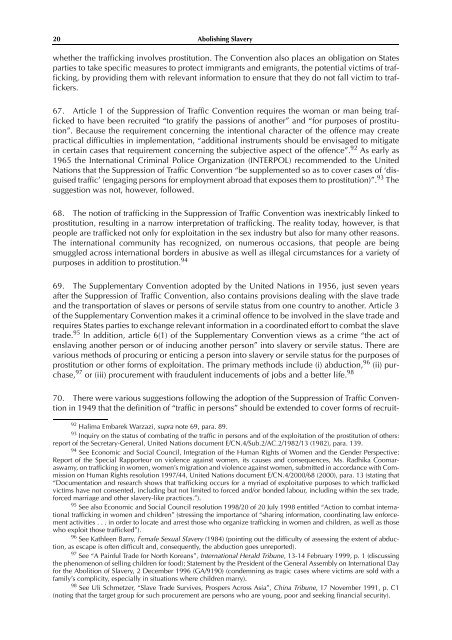Slavery in The 21st Century
Slavery in The 21st Century
Slavery in The 21st Century
You also want an ePaper? Increase the reach of your titles
YUMPU automatically turns print PDFs into web optimized ePapers that Google loves.
20 Abolish<strong>in</strong>g <strong>Slavery</strong><br />
whether the traffick<strong>in</strong>g <strong>in</strong>volves prostitution. <strong>The</strong> Convention also places an obligation on States<br />
parties to take specific measures to protect immigrants and emigrants, the potential victims of traffick<strong>in</strong>g,<br />
by provid<strong>in</strong>g them with relevant <strong>in</strong>formation to ensure that they do not fall victim to traffickers.<br />
67. Article 1 of the Suppression of Traffic Convention requires the woman or man be<strong>in</strong>g trafficked<br />
to have been recruited “to gratify the passions of another” and “for purposes of prostitution”.<br />
Because the requirement concern<strong>in</strong>g the <strong>in</strong>tentional character of the offence may create<br />
practical difficulties <strong>in</strong> implementation, “additional <strong>in</strong>struments should be envisaged to mitigate<br />
<strong>in</strong> certa<strong>in</strong> cases that requirement concern<strong>in</strong>g the subjective aspect of the offence”. 92 As early as<br />
1965 the International Crim<strong>in</strong>al Police Organization (INTERPOL) recommended to the United<br />
Nations that the Suppression of Traffic Convention “be supplemented so as to cover cases of ‘disguised<br />
traffic’ (engag<strong>in</strong>g persons for employment abroad that exposes them to prostitution)”. 93 <strong>The</strong><br />
suggestion was not, however, followed.<br />
68. <strong>The</strong> notion of traffick<strong>in</strong>g <strong>in</strong> the Suppression of Traffic Convention was <strong>in</strong>extricably l<strong>in</strong>ked to<br />
prostitution, result<strong>in</strong>g <strong>in</strong> a narrow <strong>in</strong>terpretation of traffick<strong>in</strong>g. <strong>The</strong> reality today, however, is that<br />
people are trafficked not only for exploitation <strong>in</strong> the sex <strong>in</strong>dustry but also for many other reasons.<br />
<strong>The</strong> <strong>in</strong>ternational community has recognized, on numerous occasions, that people are be<strong>in</strong>g<br />
smuggled across <strong>in</strong>ternational borders <strong>in</strong> abusive as well as illegal circumstances for a variety of<br />
purposes <strong>in</strong> addition to prostitution. 94<br />
69. <strong>The</strong> Supplementary Convention adopted by the United Nations <strong>in</strong> 1956, just seven years<br />
after the Suppression of Traffic Convention, also conta<strong>in</strong>s provisions deal<strong>in</strong>g with the slave trade<br />
and the transportation of slaves or persons of servile status from one country to another. Article 3<br />
of the Supplementary Convention makes it a crim<strong>in</strong>al offence to be <strong>in</strong>volved <strong>in</strong> the slave trade and<br />
requires States parties to exchange relevant <strong>in</strong>formation <strong>in</strong> a coord<strong>in</strong>ated effort to combat the slave<br />
trade. 95 In addition, article 6(1) of the Supplementary Convention views as a crime “the act of<br />
enslav<strong>in</strong>g another person or of <strong>in</strong>duc<strong>in</strong>g another person” <strong>in</strong>to slavery or servile status. <strong>The</strong>re are<br />
various methods of procur<strong>in</strong>g or entic<strong>in</strong>g a person <strong>in</strong>to slavery or servile status for the purposes of<br />
prostitution or other forms of exploitation. <strong>The</strong> primary methods <strong>in</strong>clude (i) abduction, 96 (ii) purchase,<br />
97 or (iii) procurement with fraudulent <strong>in</strong>ducements of jobs and a better life. 98<br />
70. <strong>The</strong>re were various suggestions follow<strong>in</strong>g the adoption of the Suppression of Traffic Convention<br />
<strong>in</strong> 1949 that the def<strong>in</strong>ition of “traffic <strong>in</strong> persons” should be extended to cover forms of recruit-<br />
92 Halima Embarek Warzazi, supra note 69, para. 89.<br />
93 Inquiry on the status of combat<strong>in</strong>g of the traffic <strong>in</strong> persons and of the exploitation of the prostitution of others:<br />
report of the Secretary-General, United Nations document E/CN.4/Sub.2/AC.2/1982/13 (1982), para. 139.<br />
94 See Economic and Social Council, Integration of the Human Rights of Women and the Gender Perspective:<br />
Report of the Special Rapporteur on violence aga<strong>in</strong>st women, its causes and consequences, Ms. Radhika Coomaraswamy,<br />
on traffick<strong>in</strong>g <strong>in</strong> women, women’s migration and violence aga<strong>in</strong>st women, submitted <strong>in</strong> accordance with Commission<br />
on Human Rights resolution 1997/44, United Nations document E/CN.4/2000/68 (2000), para. 13 (stat<strong>in</strong>g that<br />
“Documentation and research shows that traffick<strong>in</strong>g occurs for a myriad of exploitative purposes to which trafficked<br />
victims have not consented, <strong>in</strong>clud<strong>in</strong>g but not limited to forced and/or bonded labour, <strong>in</strong>clud<strong>in</strong>g with<strong>in</strong> the sex trade,<br />
forced marriage and other slavery-like practices.”).<br />
95 See also Economic and Social Council resolution 1998/20 of 20 July 1998 entitled “Action to combat <strong>in</strong>ternational<br />
traffick<strong>in</strong>g <strong>in</strong> women and children” (stress<strong>in</strong>g the importance of “shar<strong>in</strong>g <strong>in</strong>formation, coord<strong>in</strong>at<strong>in</strong>g law enforcement<br />
activities . . . <strong>in</strong> order to locate and arrest those who organize traffick<strong>in</strong>g <strong>in</strong> women and children, as well as those<br />
who exploit those trafficked”).<br />
96 See Kathleen Barry, Female Sexual <strong>Slavery</strong> (1984) (po<strong>in</strong>t<strong>in</strong>g out the difficulty of assess<strong>in</strong>g the extent of abduction,<br />
as escape is often difficult and, consequently, the abduction goes unreported).<br />
97 See “A Pa<strong>in</strong>ful Trade for North Koreans”, International Herald Tribune, 13-14 February 1999, p. 1 (discuss<strong>in</strong>g<br />
the phenomenon of sell<strong>in</strong>g children for food); Statement by the President of the General Assembly on International Day<br />
for the Abolition of <strong>Slavery</strong>, 2 December 1996 (GA/9190) (condemn<strong>in</strong>g as tragic cases where victims are sold with a<br />
family’s complicity, especially <strong>in</strong> situations where children marry).<br />
98 See Uli Schmetzer, “Slave Trade Survives, Prospers Across Asia”, Ch<strong>in</strong>a Tribune, 17 November 1991, p. C1<br />
(not<strong>in</strong>g that the target group for such procurement are persons who are young, poor and seek<strong>in</strong>g f<strong>in</strong>ancial security).

















